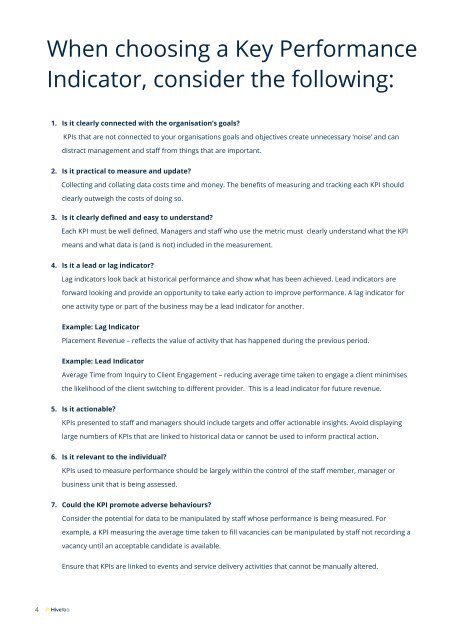Turning Your Data into Insights
Create successful ePaper yourself
Turn your PDF publications into a flip-book with our unique Google optimized e-Paper software.
When choosing a Key Performance<br />
Indicator, consider the following:<br />
1. Is it clearly connected with the organisation’s goals?<br />
KPIs that are not connected to your organisations goals and objectives create unnecessary ‘noise’ and can<br />
distract management and staff from things that are important.<br />
2. Is it practical to measure and update?<br />
Collecting and collating data costs time and money. The benefits of measuring and tracking each KPI should<br />
clearly outweigh the costs of doing so.<br />
3. Is it clearly defined and easy to understand?<br />
Each KPI must be well defined. Managers and staff who use the metric must clearly understand what the KPI<br />
means and what data is (and is not) included in the measurement.<br />
4. Is it a lead or lag indicator?<br />
Lag indicators look back at historical performance and show what has been achieved. Lead indicators are<br />
forward looking and provide an opportunity to take early action to improve performance. A lag indicator for<br />
one activity type or part of the business may be a lead indicator for another.<br />
Example: Lag Indicator<br />
Placement Revenue – reflects the value of activity that has happened during the previous period.<br />
Example: Lead Indicator<br />
Average Time from Inquiry to Client Engagement – reducing average time taken to engage a client minimises<br />
the likelihood of the client switching to different provider. This is a lead indicator for future revenue.<br />
5. Is it actionable?<br />
KPIs presented to staff and managers should include targets and offer actionable insights. Avoid displaying<br />
large numbers of KPIs that are linked to historical data or cannot be used to inform practical action.<br />
6. Is it relevant to the individual?<br />
KPIs used to measure performance should be largely within the control of the staff member, manager or<br />
business unit that is being assessed.<br />
7. Could the KPI promote adverse behaviours?<br />
Consider the potential for data to be manipulated by staff whose performance is being measured. For<br />
example, a KPI measuring the average time taken to fill vacancies can be manipulated by staff not recording a<br />
vacancy until an acceptable candidate is available.<br />
Ensure that KPIs are linked to events and service delivery activities that cannot be manually altered.<br />
4
















